Quick and Easy Low-Carb Breakfast Dishes was shared by Catherine Newman for diaTribe.org, 4 April 2022.
Looking for a breakfast dish that you can grab on your way out the door? Catherine Newman shares three delicious morning recipes you can make ahead of time that taste just as good hot or cold.
-
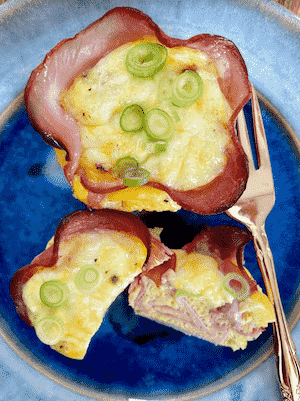 Ham and Egg Cups: These are fun and even kind of pretty, if flowers made of lunch meat can be described as “pretty.” They’re also surprisingly quick and easy to make; you can make a lot of them at once to eat at your grab-and-go leisure. Plus, you can customize as you like with different seasonings and/or chopped vegetables – just make sure not to use any that will give up a bunch of liquid and make the eggs watery (mushrooms and spinach need to be cooked first for this reason; peppers can be added raw).
Ham and Egg Cups: These are fun and even kind of pretty, if flowers made of lunch meat can be described as “pretty.” They’re also surprisingly quick and easy to make; you can make a lot of them at once to eat at your grab-and-go leisure. Plus, you can customize as you like with different seasonings and/or chopped vegetables – just make sure not to use any that will give up a bunch of liquid and make the eggs watery (mushrooms and spinach need to be cooked first for this reason; peppers can be added raw).
-
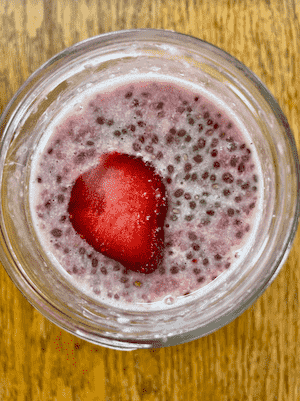 Overnight Berry Chia Pudding: Adam Brown, the author of Bright Spots & Landmines, refers to it as “A three-minute breakfast that changes lives,” and notes that, “Each 1/4 cup of chia seeds has 20 grams of carbs, though 16 grams are from fiber (80%), translating to little BG [blood glucose] impact.” It is also weirdly yummy, with a delightfully strange texture that is a little bit like a cross between bubble tea and caviar. You can use dairy milk instead of coconut milk to increase the protein or add protein powder if you like. You can also make your life easier by doubling the recipe: shake it up in a big jar and then portion it into two smaller ones.
Overnight Berry Chia Pudding: Adam Brown, the author of Bright Spots & Landmines, refers to it as “A three-minute breakfast that changes lives,” and notes that, “Each 1/4 cup of chia seeds has 20 grams of carbs, though 16 grams are from fiber (80%), translating to little BG [blood glucose] impact.” It is also weirdly yummy, with a delightfully strange texture that is a little bit like a cross between bubble tea and caviar. You can use dairy milk instead of coconut milk to increase the protein or add protein powder if you like. You can also make your life easier by doubling the recipe: shake it up in a big jar and then portion it into two smaller ones.
-
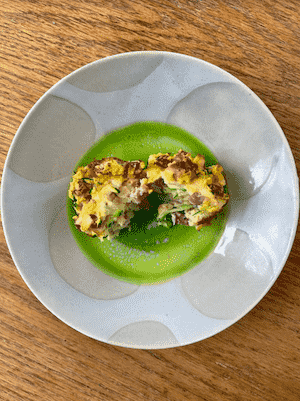 Savory Zucchini Breakfast Muffins: These satisfying little pucks are like a cross between a muffin and a quiche, and they’re wonderful. The zucchini and eggs make them healthful and nourishing, the cheese and meat make them perfectly tasty, and the coconut flour gives them a unique, moist texture. That said, there is not really a good substitute for the coconut flour, as is both low-carb and moisture-retaining
Savory Zucchini Breakfast Muffins: These satisfying little pucks are like a cross between a muffin and a quiche, and they’re wonderful. The zucchini and eggs make them healthful and nourishing, the cheese and meat make them perfectly tasty, and the coconut flour gives them a unique, moist texture. That said, there is not really a good substitute for the coconut flour, as is both low-carb and moisture-retaining
Read more: Quick and Easy Low-Carb Breakfast Dishes
Diabetes-Friendly Sushi – Your Ultimate Guide was written by Constance Brown-Riggs for diaTribe.org, 18 April 2022.
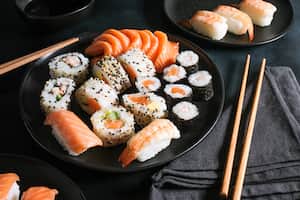 Sushi can be challenging for people with diabetes, who often refer to it as the “food they love that doesn’t love them back.” Why? Because depending on the type of sushi you order and the portion you eat, it can be a healthy pleasure or a decadent disaster.
Sushi can be challenging for people with diabetes, who often refer to it as the “food they love that doesn’t love them back.” Why? Because depending on the type of sushi you order and the portion you eat, it can be a healthy pleasure or a decadent disaster.
How is Sushi Made? Traditional sushi is made of small pieces of raw fish wrapped in rice and dried seaweed called nori. Pickled ginger, wasabi, and soy sauce are common garnishes. The rice, which is the main ingredient, is prepared with vinegar, salt, and often added sugar. That’s why sushi can be such a challenge for people with diabetes.
Rice is a food with a lot of carbs and can cause glucose levels to spike, or create a roller coaster with unpredictable swings in your glucose levels. You can reduce these “spiky” carbs with the goal of eliminating them. However, if you’re not ready to ditch sushi just yet, there are ways to make sushi more diabetes-friendly.
If you’re new to sushi, use the list below to learn about how the different types are made. These different types of sushi vary primarily in how the fish and rice are put together.
-
-
- Sashimi: Thinly sliced raw fish served by itself without vinegared rice or nori.
- Chirashi: Vinegared rice in a bowl, topped with raw fish and nori slices.
- Nigiri: A hand-pressed mound of vinegared rice, topped with a slice of raw fish.
- Temaki: Fish, vinegared rice, and vegetables hand-rolled in nori and shaped into a cone.
- Maki: Fish, vinegared rice, and vegetables rolled in nori and sliced into rounds.
- Uramaki: Sometimes called inside-out roll because the vinegared rice is on the outside, and the nori is hidden inside.
-
Is Sushi Healthy? Sushi can be healthy – many of the ingredients used to make sushi come with nutritional benefits. Fish and shellfish contain high-quality protein, heart-healthy omega-3 fatty acids, and other essential nutrients that are an important part of a healthful diet.
“Eating fish regularly has been associated with lower risks of chronic diseases like heart disease,” says Mary Ellen Phipps, a Houston, Texas-based registered dietitian and nutritionist. The American Diabetes Association (ADA) recommends people with diabetes eat 4 ounces of fish at least two times per week. Traditional sushi is low in fat, saturated fat, and cholesterol, for example:
-
-
- Tuna roll: vinegared rice, raw tuna, and nori. One roll: 194 calories, 0.8g fat, 0.3 g saturated fat, 33mg cholesterol, 67mg sodium, 21g carb, 24g protein.
- Shrimp roll: vinegared rice, raw shrimp, and nori. One roll: 155 calories, 1g fat, 0.3g saturated fat, 107mg cholesterol, 482mg sodium, 22g carb, 13g protein.
- Vegetable roll: vinegared rice, asparagus, avocado, cucumber, green onion, and nori. One roll: 206 calories, 8.2g fat, 1.2g saturated fat, 0mg cholesterol, 153mg sodium, 30g carb, 6.6g protein.
-
In contrast, “Americanized” decadent sushi is often made with less healthy ingredients high in fat, saturated fat, cholesterol, sodium, and carbohydrate. Maki and Uramaki rolls have been more Americanized than any other type of sushi. Exercise caution when eating these types of rolls, which may contain deep-fried ingredients, mayonnaise, or cream cheese, for example:
-
-
- Shrimp tempura rolls: vinegared rice, nori, battered and deep-fried shrimp, and may also have a crunchy, deep-fried coating. One roll: 400 calories, 11g fat, 2g saturated fat, 25mg cholesterol, 1160mg sodium, 61g carb, 11g protein.
- Spicy tuna rolls: vinegared rice, nori, tuna mixed with spicy mayonnaise, and maybe topped with spicy mayonnaise. One roll: 379 calories, 19g fat, 3.1g saturated fat, 43mg cholesterol, 463mg sodium, 26g carb, 23g protein.
- Philadelphia rolls: vinegared rice, nori, smoked salmon, and cream cheese. One roll: 391 calories, 14g fat, 6.3g saturated fat, 35mg cholesterol, 1115mg sodium, 55g carb, 11g protein.
-
Garnishes and sauces can also add more sodium and carbohydrate to sushi.
-
-
- 1 tbsp teriyaki sauce, 690mg sodium, 2.8g carb
- 1 tbsp wasabi, 678mg sodium, 9.2g carb
- 1 tbsp pickled ginger, 99mg sodium, 3g carb
- ½ ounce masago (roe), 380mg sodium, 3g carb
- 1 tbsp unagi (eel) sauce, 33 mg sodium, 6.8g carb
- 1 tbsp soy sauce, 879mg sodium, 0.8g carb
-
How Can You Make Sushi Diabetes-Friendly?
-
-
- Count carbs
- Opt for maki sushi instead of uramaki or nigiri
- Pair sushi rolls with other foods
- Order brown rice instead of white
- Choose sashimi over sushi rolls
- Watch out for sauces
- Ask the server questions
-
Read more: Diabetes-Friendly Sushi – Your Ultimate Guide
Remilk to open world’s largest cow-free dairy in Denmark was published by Abigail Klein Leichman for Istael21c.org, 8 May 2022.
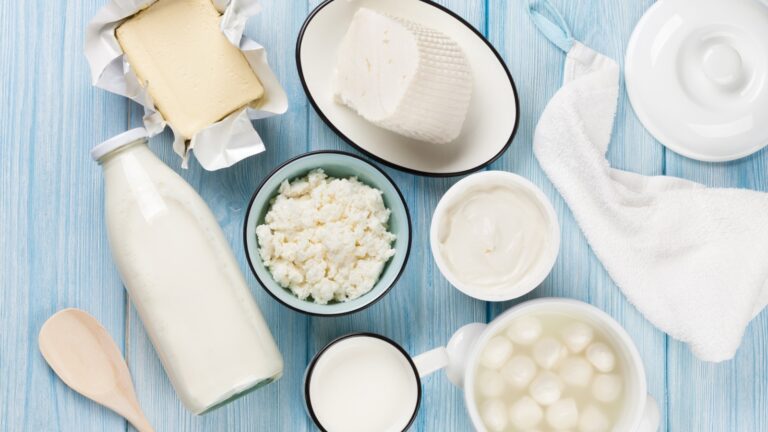 Israeli alternative dairy pioneer Remilk is building the world’s largest precision fermentation facility to produce milk proteins without cows. The Rehovot-based food-tech startup announced that its 750,000-square-foot animal-free dairy is set to open in an eco-industrial park in Kalundborg, Denmark, by the end of the year. “Our new plant in Denmark will replace 50,000 cows annually and is part of the trailblazing Kalundborg Symbiosis project: a circular approach to production, turning waste stream in one company into a resource in another,” Remilk announced.
Israeli alternative dairy pioneer Remilk is building the world’s largest precision fermentation facility to produce milk proteins without cows. The Rehovot-based food-tech startup announced that its 750,000-square-foot animal-free dairy is set to open in an eco-industrial park in Kalundborg, Denmark, by the end of the year. “Our new plant in Denmark will replace 50,000 cows annually and is part of the trailblazing Kalundborg Symbiosis project: a circular approach to production, turning waste stream in one company into a resource in another,” Remilk announced.
This refers to its use of yeast from the brewing and baking industry as a basis for fermenting chemically identical milk proteins that manufacturers can turn into milk, cheese, and yogurt without cholesterol, lactose, hormones, or antibiotics – and without harming animals or the environment as traditional dairy farming does.
Remilk was founded in 2019 and raised $120 million last January.
Read more: Remilk to open world’s largest cow-free dairy in Denmark


Oh, I love sushi. Healthy Sushi sounds like an oxymoron. Not that I think I can find healthy sushi in central Indiana. I can barely find anything but deep-fried cheese curds wrapped in double big mac buns wrapped in Rice socked in cane sugar.
Pass the yum yum sauce. I mean ketchup if in central Indiana.
informative blog…!